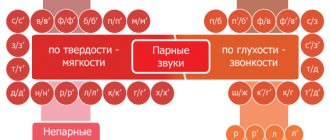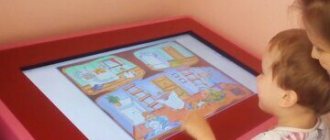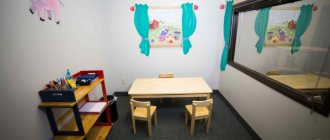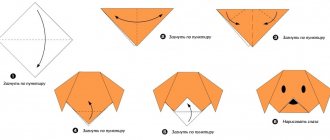“D. Davis’s Method for Eliminating Dyslexia”
“D. Davis’s Method for Eliminating Dyslexia”
The article was prepared by a teacher - speech therapist of Municipal Educational Institution Secondary School No. 51
Barashikova Natalia Viktorovna, living in the city of Tver.
Ronald D. Davis is an engineer, businessman and sculptor, founder of the Center for the Study of Reading Problems at the Dyslexia Correction Center in California, USA. Like many dyslexics, he had a difficult time at school, and teachers unanimously declared that he was “retarded.” Despite this, Davis was gifted with an unusual talent for creativity and imagination, and, having independently coped with his problem, he achieved great success in life. At the age of 38, he made a sensational discovery that allowed him to eliminate his reading problems, and for the first time was able to read a book from cover to cover without much difficulty in just a few hours. By developing his technique, Davis has helped countless people with dyslexia overcome their learning obstacles and benefit from the natural gifts it can provide. The Davis technique gives successful results in 99% of cases of its use. The essence of the technique:
help the child master the mechanism of “turning off” disorientation by establishing the so-called “orientation point”, from which, with the help of a rich imagination, you can see the world around you without distortion.
This system helps the child master the most difficult to perceive two-dimensional printed words and symbols and obtain their figurative expression in his imagination, thereby eliminating unnecessary gaps in perception. Physiological basis of the Davis method
The development of dyslexia is a very complex process, so its occurrence can be regarded as a real miracle.
A special form of information perception in dyslexics manifests itself in infancy. Even then, his brain is capable of mentally “completing” the image of his mother just by the sight of her hand or elbow. The brain function that allowed the baby to compare the image of a face seen before with the image of a part of a hand and reproduce the image of the whole person is precisely responsible for the symptoms of disorientation. Sounds too fantastic. If such work was performed by the brain of an adult, then we could explain it with analytical reasoning and logic. But before us is a three-month-old baby, recognizing things in his environment that he should not be able to recognize for another three years! And yet, he sees not an elbow, but a real person, that is, the face in his brain appears as if he saw it with his own eyes. The next stage of development for dyslexics is around 2 years of age. At this age, the child shows extreme curiosity. There are no longer any objects in the apartment that would escape his prying eyes. If a new thing appears in the room, he immediately notices it and unmistakably determines what it is. In seconds, his brain does a tremendous job of examining an object from all sides, and in his imagination the child received about 2000 options for what the proposed thing could be. If he has not seen such a thing before, it will cause confusion. Here, a dyslexic child automatically and subconsciously uses the disorientation function to recognize objects in his environment as the only correct solution. The developmental stage of a child of three to five years old includes the formation of analytical reasoning and logic skills. But a dyslexic already has his own system, which gives quick and accurate results compared to those provided by analytical reasoning and logic. A dyslexic person does not need such skills, which means that these functions do not develop in him. Therefore, he recognizes objects not consciously, like other children, but with the help of the same disorientation. Next, children begin to develop verbal conceptualization skills. In fact, the verbal process is many times slower than the mental process. Therefore, when a normal child begins to speak, he automatically begins to think more slowly. A dyslexic, in whom thoughts fly faster than speech, produces a rapid, slurred stream of words. The process of developing verbal conceptualization skills (thinking with the sounds of language) can take up to two years. Once fully developed, it will become the primary way of thinking for most children. So by the age of five, around the time kindergarten begins, typical children have already begun to think with the sounds of words. This may happen slowly, but it will come in handy as they begin to learn to read. Meanwhile, the dyslexic has never heard one of his own thoughts. He was too busy thinking in images, busy with a process of thinking that happens so quickly that he doesn't even notice he's doing it. At the age of six or seven, when children go to school and begin to learn the alphabet, difficulties await dyslexics. Printed words do not evoke in his brain the images that the word implies. The consideration of all variants of spelling of a letter or word and its absolute incompatibility with the image that it denotes automatically begins. In this case, confusion occurs, the child feels nausea and dizziness. By this point in time, confusion automatically activates a part of his brain that changes his perception. At nine years of age, frustration reaches its limit, and the dyslexic exhibits a complete learning disability. Lessons become torture. In order to somehow catch up with his peers, he begins to find his own compulsive solutions - memorization, rote memorization and associations of sounds, songs, rhymes, concentration. All this allows him to function in the world of words, although such lessons cannot be called real learning. However, in other areas - sports, drawing, applied arts - the child shows remarkable abilities, because they are explained orally or with the help of a visual demonstration. With age, the problem gets worse. But! Despite everything, the child does not lose the original gift that he developed. The gift of looking at an object or situation and “just knowing” what it is. As the dyslexic continues to observe the world, he also develops a keen intuitive understanding of how things work. He has a developed imagination and inventiveness. It is visually and kinesthetically oriented. He can think on his feet and react quickly. All these abilities are a great gift that many people lack! The Davis Method
is a comprehensive program for helping those suffering from dyslexia, helping to quickly overcome perception difficulties, disorientation and problems with reading and writing. The technique consists of several procedures that can be divided into the following components: - assessment of perceptual ability; - switching; — discharge and check; — fine tuning; — coordination; — mastering symbols; - three steps to easy reading; - mastering symbols in relation to words.
Davis Method Exercises
Referral Program
for orientation control using the Davis system.
The first question that arises for many is: “What should be the lesson plan?” Of course, for each child, the lesson schedule must be individual and determined by a specialist from the medical center. To achieve quick and effective results, an intensive course in program implementation is recommended. However, with a more extended schedule, good results are also achieved, but the total amount of time spent due to the loss of “pace” of classes will be much greater. If you do the program “little by little”, then in some cases this may negatively affect the overall goal of real correction of dyslexia.
1. Assessment of perceptual ability.
This is an initial procedure with which you can determine in which specific area of difficulty the child wants to achieve improvement.
Many parents are surprised to learn that it is more important for their child to overcome difficulties with communication or the ability to make friends than with reading or literacy in school. By applying techniques, you can help him eliminate obstacles in both industries. The technique teaches the child to create mental images and see the world around him using the so-called “mental eye”. It consists of helping the child imagine a piece of cake or an object on his hand that he can easily imagine with his eyes closed. Using various questions about the shape, color, and location of the object, the specialist determines a clear mental image of the object on the child’s hand. For a more figurative representation, the specialist seems to place the child’s vision in his own finger. By moving the finger, the child can move his mind's vision and "look" at the object from different angles. By the end of the lesson, the child can be distracted from the appearance of the object that he sees with the help of his “mental eye” and restore the original appearance of the object, mentally examining it at the level of his own eyes. He may imagine that an object has disappeared from his left hand and appeared in his right, or has changed shape or size. If the child has successfully completed the exercise provided, then you can safely move on to the next stage. 2. Switching.
The second stage of dyslexia correction is switching (visualization exercise).
The process of correcting dyslexia begins with providing control over perceptual perceptions. This means that the child can learn to consciously turn disorientation on or off. It was said above that the symptoms of dyslexia are symptoms of confusion, so once a dyslexic learns how to turn off confusion, he will be able to “turn off” all of its symptoms. After completing this exercise, you may mistakenly think that the problem has been solved, but orientation is only the first step in the process of correcting it. So, after the child has learned to “look” at objects with his “mental eye,” it is necessary to imagine that the mental eye is at the so-called point X, which is an orientation point for him. This mental point is located at the end of an imaginary line running from the previously imagined object on the patient’s hand through the nose, head and is located approximately 30 centimeters from the top of the back of the head. An anchor, which is the intersection of imaginary lines going to point X from the ears and the frontal part of the head, will help to “fix” this particular place for viewing with the “mental eye” at this point. Once the child imagines this place, there is no need to keep in mind the imaginary object and the line coming from it. Now it represents only the intersection of the remaining lines and the place where the "mind's eye" will need to be placed to turn off the disorientation. In fact, the specialist is interested in a group of brain cells located in the upper part of the brain and responsible for disorientation. When these cells turn off, the brain sees exactly what the eyes of non-dyslexic people see. That is, if the patient places his mental eye at this point, he automatically “turns off” his disorientation. The process of placing the mind's eye on the point of orientation must be repeated constantly to prevent disorientation from confusing the mind. The process of keeping the mental eye exactly at this point, but without tension, is also important, otherwise the child may get a headache. 3. Discharge and check.
This is the stage at which the child learns to give relief to a tired imagination, which cannot hold the “mental eye” for long at the point of orientation and can shift its imaginary location.
Keeping the mind's eye at the point of orientation and not allowing it to jump is a rather difficult task. The point is that the “leap” of the mental eye does not happen on its own. When the patient finds himself in a state of confusion, he tries to move the mind's eye and at the same time tries to prevent it from moving. This process is called "holding." When a child tries to keep the “mental eye” motionless for a long time, he will involuntarily rub the back of his neck, complain of a headache, and frown. Then you need to “discharge.” The feeling of release is the same feeling you feel when you sigh. If the breath is deep, then the discharge is felt throughout the body, right down to the tips of the fingers and toes. This is the same sensation that a tired “mental eye” should feel. To do this, you just need to want such a feeling to arise in your mental eye. You will immediately feel relief in the neck muscles. If you transfer the feeling of relaxation to your head, the headache will disappear. After some time, the orientation point established in the first lesson may change its location. You can check this by asking the child to place his finger at this point. If the point is shifted from the correct location, then you need to make a small adjustment by placing your finger in the desired location. Once the orientation point has been “adjusted”, you can move on to the next step 4. Fine tuning.
This is a procedure by which the child can find his optimal orientation point, that is, the point at which the orientation will be sufficiently accurate. It is important to remember that this procedure must be carried out when the manifestations of “swimming” of the mental eye relative to the orientation point stop. By moving the mental eye around the existing point of orientation, you can determine its optimal location for the child. You can move your mind's eye in any direction, but every time you move it, the child will feel a loss of balance. If the point of orientation is shifted to the right, then the body loses balance, leaning to the right. However, with a slight shift, the child can find his own mind's eye location where he feels most comfortable. Then he will have an ideal sense of balance, and he will be able to stand on one leg without making additional movements in the foot. In addition, dyslexics typically experience a deep sense of well-being. If the optimal point has been found, it is necessary to strengthen it with an anchor. However, the optimal location may change from time to time. By performing the fine-tuning exercise, the child will be able to easily adapt and again find “his” point of orientation.
5. Coordination.
A method by which you can forever eliminate confusion in the concepts of “right” and “left.”
This process aims to address dyspraxia or clumsiness. Coordination must be carried out periodically after the Fine Tuning procedure. First you need to check the child’s orientation point. Then ask him to stand on one leg and balance his body. Taking 2 small soft balls, you need to throw them so that he catches them with different hands (one with one hand, the other with the other hand), first in turn, then simultaneously, and then simultaneously with a tilt to the right or left so that the child crosses the line of symmetry your body in order to catch both balls. He must catch them without losing his balance. By periodically performing this exercise, clumsiness can be reduced to nothing. This exercise is also good to do during a break when using the following “Mastering Symbols” technique for small words. 6. Mastering symbols.
Difficulties in reading and writing, as well as problems in understanding printed text, can also be solved.
Earlier it was said that a dyslexic child has problems with the perception of printed symbols, which in his understanding are not perceived as images. These can be prepositions, interjections, individual words that are difficult to imagine. As you know, a misunderstood or misunderstood word leaves a void in perception, and a piece of the text you read simply flies out of your head. What should a child who studies at school do, because he has to read, learn poetry, formulas and theorems? A dyslexic's perception is such that it only accepts a three-dimensional image. A two-dimensional and also incomprehensible symbol can cause confusion and disorientation. Let’s conventionally call such words and symbols “triggers” of dyslexia. For most dyslexics, symptoms of confusion can be triggered by certain letters of the alphabet and punctuation marks, mathematical symbols and numbers. Solution.
According to statistics, 20% of what a person hears, 40% of what he sees, and 80% of what a person does himself is absorbed.
So, for best mastery, the child must make letters, words, signs, numbers himself in a three-dimensional, tangible image and identify it with ordinary printed letters and numbers. After this, the child must check whether the letters are located correctly and whether they are in the same sequence. He must be able to recite the alphabet in forward and reverse order. If some letters cause him difficulties, then he needs to work with these letters. The child must say how the molded and written letters differ, what letters come before and after it, in a word, work with this letter until it no longer causes difficulties. With symbols it’s a little different. The child must learn to find punctuation marks in the text and know what to do when he sees such a sign in the text. It is important to be able to give examples of how a punctuation mark or other sign or symbol is used. 7. Three steps to easy reading.
The attention of dyslexics is somewhat scattered.
Looking at an object, they will perceive it not in parts, but only as a whole. Therefore, they also look at the word as one whole. And they learn to read by looking at whole words and guessing what a given word is. Such guessing eliminates the sense of certainty necessary to gain confidence in one's abilities. The first step
is to spell it.
Goals: - to teach the child to move his gaze from left to right when reading; - help learn to recognize groups of letters as words. At this stage, reading comprehension is not necessary. The main goal: learn to recognize letters in a word and read them in the order in which they are written. This technique trains the brain and eyes to move through a word from left to right when reading. Dyslexics have trouble reading if they either try to read too quickly or focus too much on the material they are reading. Therefore, it is necessary to choose the easiest book so that it can be read without stress. If a child becomes confused at the sight of a large number of words, then you can cover the text below the readable line with a piece of paper. It is very important not to miss the moment when the child becomes disorientated. Then you need to check the location of the orientation point and take a short break. The second step
is to skim and read the letters.
Goal: to continue the process of moving the gaze from left to right and recognizing words. If the child cannot pronounce what he has just read, then you must first ask him to spell the word again and tell him what it means, and then ask him to repeat it. Once you recognize most letters, you need to move on to a more complex level of reading. The third step
is punctuation in images.
Goal: understanding the material being read. In any language, after every completed thought there is a punctuation mark, with their help it stands out. Every complete thought can be depicted or felt. After reading, the child needs to add meaning to what he just read. When you encounter a punctuation mark, you need to ask him to imagine in his mind what he just read. If a child comes across a word that is not a trigger of disorientation, but it is not understood, then it is necessary to master the very meaning of the word by reading it in a simple dictionary. 8. Mastering symbols in relation to words.
Most people do not know the definitions of common words, which are the most commonly used words in a language. For example, many find it difficult to give any other definition of the word “in” other than that it is a preposition. The procedure of the “Mastering of Symbols” technique consists of several stages: - look up the word in the dictionary; — find out how it is pronounced (transcription); - read the first definition out loud along with the sentence given as an example; - establish a clear understanding of the definition, discuss it, create sentences or phrases using this word with such a definition; - make a model of the concept described by the definition from plasticine (for example, to depict the preposition “in”, you can sculpt the image of a “fork in a socket”, or the scene of “children playing a game”); - make a symbol or letters of a word from plasticine and make sure the spelling is correct; - create a mental image of what was created; - say out loud: “This word means definition (This high means more than normal height)”, say out loud to a word or symbol: “It says (word) ...” You must continue to form sentences and phrases until you can do it easily and no tension.
Development of reading technique in schoolchildren with dyslexia
A person remembers not what is constantly before his eyes, but what flashes. Therefore, in order to master some skills and bring them to automatism, it is necessary to carry out not long exercises, but short ones, but with great frequency. An hour and a half of training will not give any benefit and will even suppress any desire in the child to read. It is much better to do them for 5 minutes several times a day and even before bed. 1. The buzz reading method is very interesting. With buzz reading, you read with your child at the same time out loud, in a low voice, each at your own speed, for 5 minutes. 2. Reading before bed gives good results. The fact is that the last events of the day are recorded by emotional memory, and during sleep a person is under their impression. The body gets used to this state. It is not for nothing that 200 years ago it was said: “Student who lives by science, learn the psalter for the coming sleep.” If a child does not like to read, then a gentle reading regime is necessary: one or two lines are read, then a short rest is arranged. This mode occurs when a child watches filmstrips: he read two lines under the frame, looked at the picture, and rested. Filmstrips should have entertaining content (fairy tales, adventures). The development of reading techniques is hampered by underdeveloped RAM: after reading three or four words, the child already forgets the first and cannot understand the meaning of the sentence. This situation can be corrected with the help of visual dictations developed by Professor I. T. Fedorenko (Kharkov). Each of the 18 sets contains 6 sentences: the first (“The snow is melting”) contains only two words of 8 letters, and the last contains 46 letters; the length of the sentence increases gradually, one letter at a time. What is the best way to conduct visual dictations? Write down on a piece of paper for the child either 5 sentences at once, which are opened one at a time, or one is written. A certain time is allotted for reading each sentence, which is indicated after it. Your child reads the sentence silently and tries to remember it. Invite him to close his eyes and imagine how it is written, and repeat it to himself. Then remove the piece of paper with the written sentence. The child writes down the text. Visual dictations should be written daily.
Texts of visual dictations (according to I. T. Fedorenko)
Dictation 1
1. The snow is melting.
(8 letters) 2. It is raining. (9) 3. The sky is gloomy. (10) 4. Kolya got sick. (11) 5. The birds began to sing. (11) Dictation 2
1. The field is empty.
(12) 2. The frost is crackling. (12) 3. I'm looking for strawberries. (13) 4. A spruce tree grew in the forest. (13) 5. Autumn has come. (14) Dictation 3
1. The days have become shorter.
(14) 2. There are many birches in the forest. (15) 3. The birds have arrived. (15) 4. The sun is shining brightly. (16) 5. Lida wiped the board. (16) Dictation 4
1. Streams run merrily.
(16) 2. A sharp wind blew. (16) 3. Zoya studies diligently. (17) 4. The woodpecker was hammering the tree. (17) 5. I want to plant flowers. (18) Dictation 5
1. Frost fluffed up the trees.
(18) 2. Without water, flowers wither. (19) 3. The hot summer has flown by. (19) 4. A spruce tree was planted near the house. (20) 5. The sun is shining and warming. (20) Dictation 6
1. Fedya solved the problem at the board.
(21) 2. The dawn lit up in the sky. (21) 3. Frost sparkled on the trees. (21) 4. The city of Kyiv is located on the Dnieper. (22) 5. They are picking strawberries in the forest. (22) Dictation 7
1. In winter, the river was covered with ice.
(23) 2. The boy gave his mother flowers. (23) 3. Peasants work in the meadow. (23) 4. The attendants wiped the dust off the board. (24) 5. The chickens got out of the box. (24) Dictation 8
1. We lived near a birch grove.
(24) 2. The sky was covered with gray clouds. (25) 3. The children planted an acacia tree in the yard. (25) 4. Grandmother bought an ABC book for her grandson. (25) 5. The warm sun warmed the earth. (26) Dictation 9
1. My sister works in a factory.
(26) 2. The spring sun warmed tenderly. (26) 3. It is raining. (10) 4. We love our Kyiv. (14) 5. Take care of your school things. (17) Dictation 10
1. Andrey has a blank notebook.
(20) 2. Help your friend. (21) 3. The waters of the seas taste salty. (22) 4. Our country is fighting for peace. (22) 5. These boys are funny guys. (24) Dictation 11
1. The children went to the forest to pick mushrooms.
(23) 2. A big change has begun. (23) 3. Boys are future excellent students. (24) 4. The streets of our city are beautiful. (24) 5. Moscow is the capital of our Motherland. (24) Dictation 12
1. Schoolchildren water the seedlings.
(24) 2. Deputies gathered for the congress. (24) 3. We must be honest and truthful. (25) 4. The stars shine on the Kremlin towers. (25) 5. In the summer our family lived on the Volga. (25) Dictation 13
1. Thick rye is spiking merrily.
(25) 2. The fields were covered with white snow. (25) 3. We read an interesting story. (25) 4. The scientist worked a lot and hard. (25) 5. New houses are growing very quickly. (26) Dictation 14
1. Mitrofan Fomich got out of the car. (26) 2. The boys brought dry branches. (26) 3. Rye and wheat are ripening in the field. (26) 4. Young people came to the construction site. (24) 5. Children of all countries want to live in peace. (27)
Dictation 15
1. A fresh breeze blew cool.
(28) 2. Lightning flashed and thunder roared. (28) 3. Farmers have long since mowed the meadows and fields. (28) 4. The squirrel climbed onto the top branch. (29) 5. The sun was shining brightly, and the children were swimming. (30) Dictation 16
1. The whole nation is proud of the space heroes.
(29) 2. Grandfather Philip tends a large herd. (30) 3. I love to watch the sunrise in the field. (32) 4. A large gray cloud rose across the river. (32) 5. Evenki hunters live in the distant taiga. (33) Dictation 17
1. Everyone was happy to meet the astronauts. (33) 2. The scouts set off on a dangerous journey. (33) 3. A friendly family will turn the land into gold. (34) 4. Shoes should always be cleaned of dust. (34) 5. Our cheerful garden will bloom and turn green. (34)
Dictation 18
1. Blueness appeared between the thinning tops.
(35) 2. The free wide steppes of Ukraine are good. (35) 3. The dog barks at the brave, but bites the cowardly. (36) 4. The school tells us to work, the detachment teaches us this. (36) 5. Our people want to live in peace with all nations. (37) Dictation 19
1. In the taiga there are predatory animals: wolves, lynxes.
(36) 2. The moon makes its way through the wavy fogs. (36) 3. Schoolchildren are preparing for the new school year. (37) 4. A lot of work in the school garden in early spring. (36) 5. There is a holiday camp on the seashore. (34) Dictation 20
1. Soon the sky will be covered with clouds and it will drizzle. (38) 2. One day, in the cold winter, I came out of the forest. (38) 3. Water broke out from under the ground, and a spring was born. (39) 4. Builders built a highway from the city to the taiga. (37) 5. The flowers were unfamiliar, like bells. (40)
Dictation 21
1. Cool water is good for refreshing tired guys.
(41) 2. The waves play, the wind whistles, and the mast bends and creaks. (42) 3. Victory over the enemy filled the warrior’s chest with happiness. (42) 4. Every day thousands of people move into new apartments. (43) 5. Schoolchildren grow tangerines, lemons, and oranges. (44) Dictation 22
1. A border guard walks carefully along an overgrown forest path. (45) 2. The boss went to the window and saw a house under construction behind it. (46) 3. Our country lives in peace and friendship with other nations. (43) 4. Part of Siberia is covered with steep and steep mountains. (43 5. The beautiful full-flowing Yenisei River flows through our region. (46)
Reading at the pace of a tongue twister is intended to develop the articulatory apparatus
, special attention is paid to the clarity of reading the endings of words.
Work is constantly being carried out on the development of phonemic hearing
, using purely sayings, tongue twisters, proverbs, and sayings.
An indispensable condition for improving reading technique is constant systematic work on the analysis and synthesis of words.
Basic techniques and methods of working with dyslexic children:
- Breathing, visual and articulation gymnastics.
- Method of kinesiological correction.
- Stimulating massage and self-massage of hands and fingers.
- Rhythmic-speech, music and vitamin therapy.
- Mirror-symmetrical drawing with both hands.
- Exercises for the development of visual-motor coordination, operational reading field, anticipatory perception of words.
- Modified visual dictations by Fedorenko-Palchenko.
- Intellectually developing word games: anagrams, isographs, puzzles, cryptograms, upside-downs, magic chains, word labyrinths, matryoshka words and others.
- Search tables for the words “Photo Eye”.
- The method of “voice” reading.
- Method of verbal anagrams.
Automation of operational reading units using special syllabic tables.
14
Correction of dyslexia from 5 days is real!
I would like to leave a review about Anna’s work; I just finished the correction course today. We are from Yekaterinburg and studied with Anna remotely, although initially the plan was to come to her in Moscow in June. I was very worried that due to the current situation in the world, we would not be able to get to the correction at all. Therefore, when Anna wrote that it was possible to study online, I immediately agreed. Now about the correction itself. My son Kirill is 12 years old and finishing 6th grade. All these years, his studies have been a real challenge for our entire family! He could not read without errors; he did not understand what he was reading about. Moreover, both just books and math assignments or test assignments. In general, in Russian and literature - a stable 2, with a stretch of three in the quarter. Well, he couldn’t do all the other subjects, like history, biology, geography, without outside help. I sat and waited until my husband or I came home from work, read it and explain it. The dyslexia correction course took 10 days, although it was planned that with personal training it would take 5 days. Anna and I agreed that we would study for 3 hours a day; Anna did not advise longer, and I am not a supporter of children spending so much time on the computer. During classes they took breaks and Kirill had the opportunity to rest. I want to write so many enthusiastic things that my thoughts are confused! On the fourth day of classes, I noticed that Kirill became more attentive, more concentrated, and less distracted. He sat down to do his homework himself, there was no shirking or whims. They were asked to learn a poem. And for the first time he did not call me for this. I did everything myself, I was just checking! Reading has become much better!!! Understanding of the text has appeared! He himself read and retold the paragraph on biology. But only 10 days have passed! Now we both work out with great enthusiasm because we see the results. He has grown wings! I see that I have gained faith in myself! I want to consolidate this, so we study according to the schedule. Now he is not afraid of big tasks in Russian. I see that at first fear will flash in his eyes out of habit, but he immediately brushes it aside, sits down and does it. I will write this review mainly for those who do not live in Moscow. Don't be afraid of a distance correction course! The results are surprising! And for us it turned out to be much cheaper! I didn’t need to buy plane tickets, I didn’t need to pay for housing in Moscow, for a taxi, etc. Well, I was mentally worried: how will we get there, how will we settle in, how will we find him, how will we leave the youngest... But here we didn’t have to! We are very pleased! The only thing is that you will have to be in touch during classes, because you need to print something, find a ruler, or adjust the camera.








